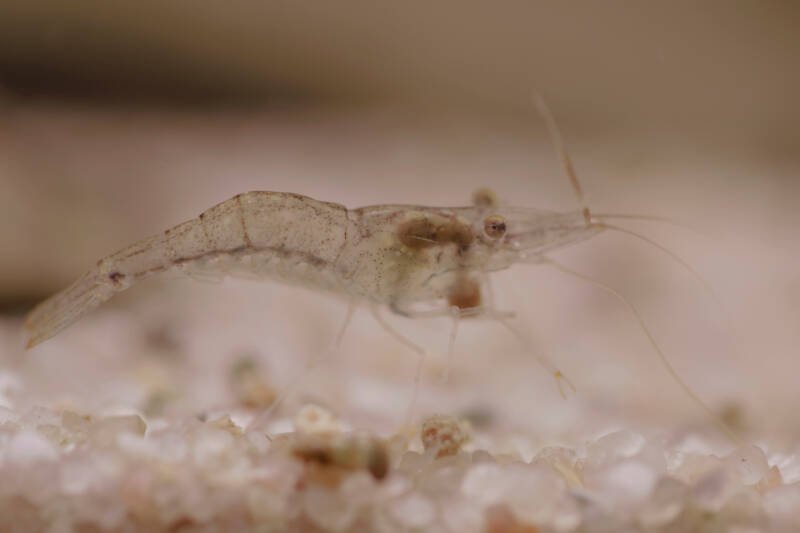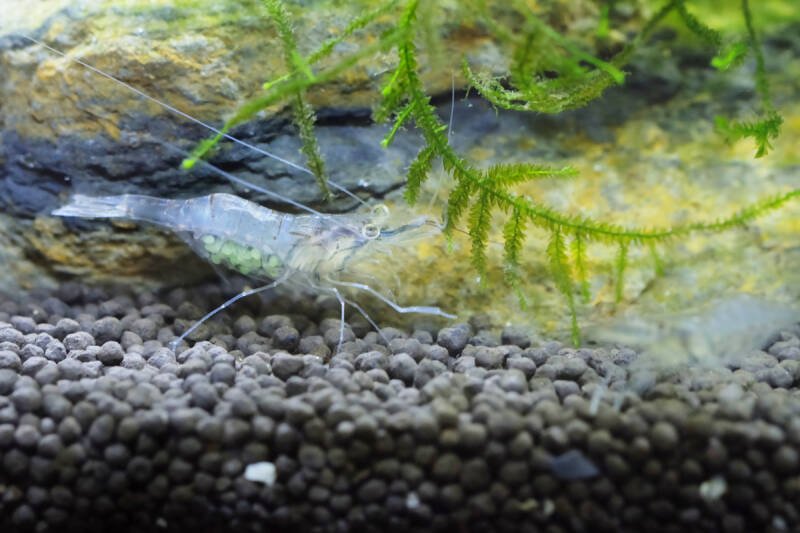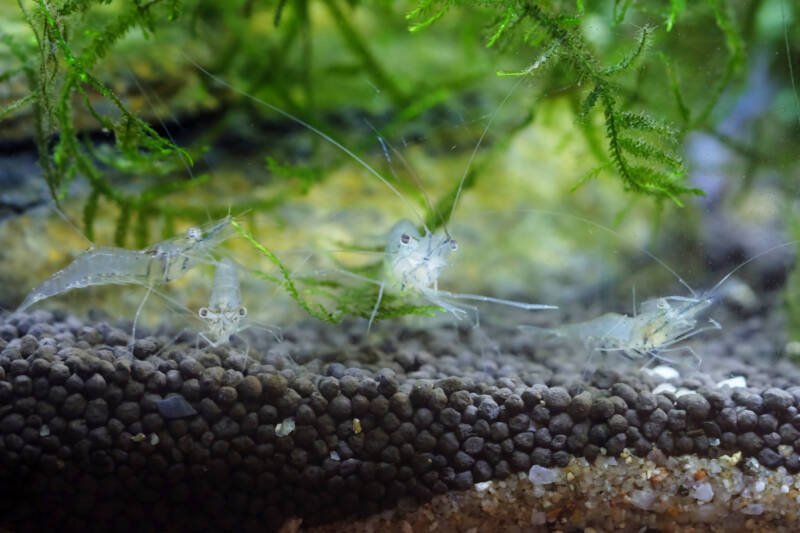Of all the aquatic creatures you can add to your home aquarium, the ghost shrimp is perhaps one of the most unique.

With their fully transparent bodies, they busy themselves along the tank bottom, cleverly blending in as they help clean your tank.
Ghost shrimp are prized by some aquarium keepers for their low biological footprint and their peaceful nature.
Other keepers value the shrimp for their use as feeders for larger fish in the aquarium.

Take a close look at your ghost shrimp, and you will see their internal organs. You can even observe the food they eat as it makes its way through their digestive system.
But what does it mean if you see green dots under the tail of your shrimp? It means your ghost shrimp is a female and is carrying eggs!
Before you start celebrating, read on for information on caring for your pregnant ghost shrimp.
In this article
Ghost Shrimp Biology

Ghost shrimp (Palaemonetes paludosus) are freshwater shrimp originating in the lakes and rivers of North America’s Atlantic Coastal Plain (extending from southern New Jersey to the tip of Florida).
While found primarily in freshwater, they can also tolerate brackish water of low salinity.
This species prefers the vegetation-dense bottom areas of wetlands and streams with clear water.
In the wild, the shrimp also enjoy waters with aquatic grasses or water hyacinths.
The males grow to an adult size of about 1.5 inches (4 cm). Females can grow slightly larger, almost 2 inches (5 cm), in length, and are more rounded in the abdomen.
Their lifespan can range from one to one and a half years.
Indications That Your Ghost Shrimp is Pregnant

Male and female ghost shrimp look very similar until they have reached breeding age.
At that point, you will be able to tell the female from the male by the presence of small, round, green eggs under her tail.
Due to the shrimp’s translucent body, these eggs will be easily visible.
Ghost Shrimp Gestation Period
Once you see these eggs, wait a few days to ensure the males fertilize them. After that, the gestation period is from 12 to 14 days.
Set Up a Breeding Tank

While ghost shrimp do well in a community tank, when it comes to the successful birth and raising of baby shrimp, setting up a separate breeding tank is best.
Otherwise, the young can be eaten by the adult shrimp or other fish in the tank.
A good rule of thumb for how many ghost shrimp in a tank is no more than 10 shrimp per gallon of water in a species only tank.
Plan on keeping the young shrimp in this separate tank until they grow to a suitable size before introducing them to the community tank.
Tank Setup
Line the bottom of the tank with a fine substrate. Ghost shrimp scavenge along the bottom and cannot shift larger grained linings to search for food.
Add some live plants as well, such as java moss or hornwort. These plants will serve many purposes.
Not only will these provide food sources for your ghost shrimp (they will snack on algae or organic matter attached to the plants), but they will give areas for your shrimp to find shelter. They will also help keep the water well oxygenated.
In addition to the live plants, consider adding driftwood, rocks, or artificial caves to give your ghost shrimp places to retreat if threatened or to hide after molting.
Ghost shrimp shed their shells frequently as they grow and need a place to hide for a little while to allow their new shells to harden.
Water Parameters
Ghost shrimp can thrive in a wide range of water temperatures and conditions.
For optimum health of your shrimp, maintain the water temperature between 65- and 82-degrees Fahrenheit (18 – 28 degrees C).
Water pH level should be between 7.0 and 8.0. Keep the water hardness between 3.72 and 6.75.
Change out a portion of the water (anywhere from 10 to 25% of the tank) each month.
Doing this regularly will help to keep the ammonia, nitrite, and nitrate levels from elevating. You can monitor these levels using test kits (very easy to use).
Equipment
While adult ghost shrimp are decent swimmers, the newborn and young shrimp are not. As such, there is a danger of them being sucked into the filter if you use a high-powered system.
Install a sponge filter for the breeding tank. In addition to protecting your young shrimp, the gentle current provided by this filter will be more comfortable for the adults.
Adding an air pump, in addition to the live plants, can help keep the water well oxygenated.
Ghost shrimp spend their days on the bottom of the tank and do not require any specific lighting if you have adequate plant cover.
Breeding
In the wild, ghost shrimp spawn in the months between April and October.
The ideal water temperatures for breeding depend on the area the shrimp inhabit.
They breed in water temperatures between 64.4- and 73.4-degrees Fahrenheit (18 and 23 degrees C) in the northern waters and 78.8- and 82.4-degrees Fahrenheit (26 and 28 degrees C) in the southern waters.
In these warmer waters, shrimp can breed twice per year (something to keep in mind for the shrimp in your aquarium).
There are no special requirements for breeding ghost shrimp. Often, simply having males and females in the tank will result in a pregnant female.
Unfortunately, in a community tank, there are some challenges to keeping the newborn shrimp alive long enough for them to mature.
The best course of action is to separate your pregnant female as soon as you notice the eggs developing within her.
Feeding Your Pregnant Ghost Shrimp
Your pregnant ghost shrimp will not need any special diet in addition to what you are already feeding them.
In the wild, ghost shrimp are omnivorous scavengers. They will eat vegetation (both algae and plants) and some insects and detritus from animals or plants.
In your aquarium, it does not hurt to supplement your shrimp’s diet from time to time with some sinking wafers or high nutrition flakes.
Your ghost shrimp may also enjoy snacking on some soft vegetables as well.
Feed them two times per day and do not overfeed, as they can scavenge on algae and other detritus in the tank.
The Birth of Your Baby Ghost Shrimp
A female ghost shrimp can carry anywhere from 8 to 85 eggs in a group near her tail.
Once fertilized, the incubation period is from 12 to 14 days. Afterward, the tiny, delicate larvae are born free swimming.
After Your Ghost Shrimp Gives Birth
You want to ensure that your baby ghost shrimp have a chance to grow into adults.
The separate breeding tank you have set up will ensure they do not get eaten by other fish in the community tank.
It will also allow them to get the food they need to grow, as it will not be consumed by other fish. Finally, the lack of predatory fish will allow the baby shrimp to mature and grow large enough to be introduced into the community tank.
Make sure and remove the adult shrimp from the breeding tank after the young are born.
Due to their scavenger nature, there is a good chance the adult ghost shrimp will eat the newly born babies.
Keep the young separate until they have grown large enough to be introduced into the community tank, usually about five weeks.
Baby Shrimp Care and Feeding
The newborn shrimp have tiny mouths and thus require very small-sized food.
For the first week or so, infusoria is a good size and easy enough for them to ingest.
Some breeders found success using java moss mops in the breeding tank to promote algae growth for the baby shrimp to eat.
You can even try liquid fry food.Excellent foods to feed your baby shrimp for the first few weeks include:
- Infusoria
- Algae powder
- Cultured microworms.
After about a week, as the shrimp grow larger, some breeders recommend using pulverized fry food, such as flakes. As the shrimp grow bigger, introduce:
- Finely pulverized flakes
- Baby brine shrimp.
Frequently Asked Questions
1. How long do ghost shrimp stay pregnant?
Once the eggs are fertilized, ghost shrimp females will carry them for about two weeks (12 to 14 days), fanning them frequently.
After that timeframe, the young are born as live larvae.
2. How many babies do ghost shrimp have?
A female ghost shrimp can give birth from as few as eight to as many as 80 young at a time.
3. How do ghost shrimp give birth?
After about two weeks of gestation, ghost shrimp larvae are born live and free-swimming.
In one to two weeks, they will look like miniature versions of the adult shrimp.
4. How do you take care of a pregnant ghost shrimp?
There is not much to do to care for pregnant ghost shrimp.
The most important things are to set up a separate breeding tank, remove the female shrimp after the young are born, and allow the larvae to grow before they are introduced to the community tank.
5. Will ghost shrimp die after laying eggs?
That question is easy to understand, given that ghost shrimp have a short lifespan of about one year.
However, researchers have seen that the ghost shrimp breed multiple times in warmer waters, so the answer is: no, they do not die directly after laying eggs.
6. Can ghost shrimp breed in a community tank?
Yes, ghost shrimp can breed in a community tank, although it may be more difficult to ensure the young’s survival because they can be eaten by the adult shrimp or other fish in the tank.
To prevent this from happening, it is better to set up a separate breeding tank until the shrimp have grown to a large enough size to introduce to the community tank, typically around five weeks.
Closing Thoughts
Whether you intend your ghost shrimp to be lovely and interesting additions to your aquarium or plan to use them as feeders for your fish, it is helpful to understand how they breed and give birth to increase your odds of having healthy, surviving young.
Luckily, there are not many adjustments required to breed your ghost shrimp, and with so many benefits to your tank in the way of cleaning it and visual interest, it is easy to see why the ghost shrimp is a popular addition to many home aquariums.
Have you had success in breeding your ghost shrimp? What have you found works best for a breeding tank setup?
What food have you found works best for your newborn shrimp?
We would love to hear from you!